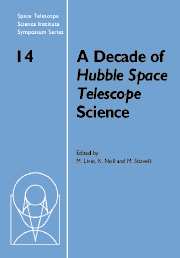Book contents
- Frontmatter
- Contents
- Participants
- Preface
- HST studies of Mars
- HST images of Jupiter's UV aurora
- Star formation
- SN1987A: The birth of a supernova remnant
- Globular clusters: The view from HST
- Ultraviolet absorption line studies of the Galactic interstellar medium with the Goddard High Resolution Spectrograph
- HST's view of the center of the Milky Way galaxy
- Stellar populations in dwarf galaxies: A review of the contribution of HST to our understanding of the nearby universe
- The formation of star clusters
- Starburst galaxies observed with the Hubble Space Telescope
- Supermassive black holes
- The HST Key Project to measure the Hubble Constant
- H0 from Type Ia supernovae
- Strong gravitational lensing: Cosmology from angles and redshifts
Stellar populations in dwarf galaxies: A review of the contribution of HST to our understanding of the nearby universe
Published online by Cambridge University Press: 13 August 2009
- Frontmatter
- Contents
- Participants
- Preface
- HST studies of Mars
- HST images of Jupiter's UV aurora
- Star formation
- SN1987A: The birth of a supernova remnant
- Globular clusters: The view from HST
- Ultraviolet absorption line studies of the Galactic interstellar medium with the Goddard High Resolution Spectrograph
- HST's view of the center of the Milky Way galaxy
- Stellar populations in dwarf galaxies: A review of the contribution of HST to our understanding of the nearby universe
- The formation of star clusters
- Starburst galaxies observed with the Hubble Space Telescope
- Supermassive black holes
- The HST Key Project to measure the Hubble Constant
- H0 from Type Ia supernovae
- Strong gravitational lensing: Cosmology from angles and redshifts
Summary
This review aims to give an overview of the contribution of the Hubble Space Telescope to our understanding of the detailed properties of Local Group dwarf galaxies and their older stellar populations. The exquisite stable high spatial resolution combined with photometric accuracy of images from the Hubble Space Telescope have allowed us to probe further back into the history of star formation of a large variety of different galaxy types with widely differing star formation properties. It has allowed us to extend our studies out to the edges of the Local Group and beyond with greater accuracy than ever before. We have learned several important things about dwarf galaxy evolution from these studies. Firstly we have found that no two galaxies have identical star formation histories; some galaxies may superficially look the same today, but they have invariably followed different paths to this point. Now that we have managed to probe deep into the star formation history of dwarf irregular galaxies in the Local Group it is obvious that there are a number of similarities with the global properties of dwarf elliptical/spheroidal type galaxies, which were previously thought to be quite distinct. The elliptical/spheroidals tend to have one or more discrete episodes of star formation through-out their history and dwarf irregulars are characterized by quasi-continuous star-formation.
- Type
- Chapter
- Information
- A Decade of Hubble Space Telescope Science , pp. 128 - 152Publisher: Cambridge University PressPrint publication year: 2003
- 3
- Cited by



